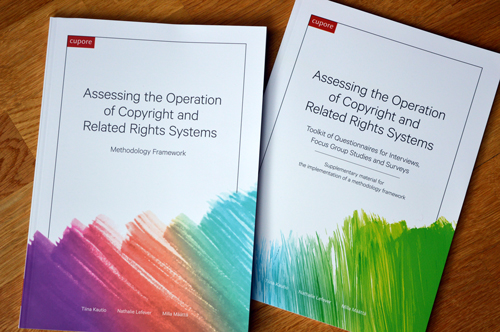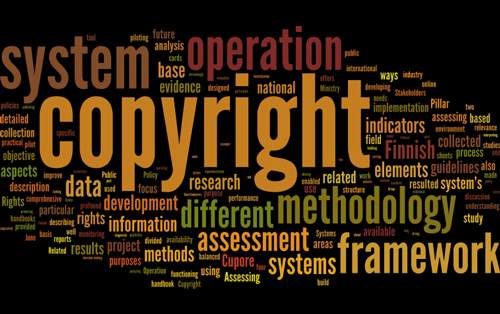Assessing the operation of copyright and related rights systems

The importance of objectively collected research evidence on the operation of the copyright system has been increasingly underlined in the past ten years. The Finnish Ministry of Education and Culture has long supported the development of research methods to improve the monitoring of the copyright system’s operation.
Between 2009 and May 2016, the Ministry financed a project conducted at the Center for Cultural Policy Research (Cupore) which resulted in a methodology for a systematic assessment of the functioning, performance and balanced operation of national copyright and related rights systems. The methodology framework, published in June 2016, helps build a profound understanding of the copyright system, its different elements and different aspects of its operation, therefore serving as a tool in the formulation of copyright policies and strategies. It can facilitate the development of the copyright system by helping to identify areas and solutions for improvements and by monitoring the effectiveness of particular elements of the system. Its purpose is also to increase the transparency of the copyright system and to provide an information base for public discussion on copyright policy.
Tools for assessing the copyright system’s operation
The framework is divided into three pillars that can be implemented one at a time, as sequential phases or using only specific elements or aspects of interest: Pillar I outlines methods for describing and analyzing the copyright environment, Pillar II includes methods for describing and assessing different elements of the copyright system as divided under four particular areas (Law, Policy and Public Administration; Enforcement; Management of Rights; and Dissemination of Knowledge), and Pillar III concerns the assessment of the operative balance of the copyright system through four separate aspects (Incentives; Access; Licensing Markets; and Infringement, Opinions and Public Acceptance).
In the methodology, the assessment of the copyright and related rights system is organized through 15 description sheets and 22 methodology cards. The description sheets constitute guidelines to produce a comprehensive presentation and description of a country’s copyright and related rights system and its operating environment. The methodology cards propose the collection of specific sets of data, either quantitative, descriptive or qualitative, that will be used as indicators of the functioning, performance and balanced operation of the system.
Sometimes the data can be gathered as a desktop study using available statistical or other sources and in other cases the data is to be collected through interviews, focus group study or survey-based research.
In the process of building the framework, the identification and evaluation of potential indicators was made in cooperation with both Finnish and international experts in the field of copyright. The data to be collected was selected on the basis of its relevance, neutrality and availability as well as its anticipated validity in the assessment of copyright systems’ operation on a world-wide scale, its availability, and the relevance of the information it provides.
Different ways of using the framework
The methodology is designed to follow a modular structure: besides offering methods for undertaking a comprehensive analysis of the system as a whole, it allows for a detailed analysis of its elements and aspects separately. It also suggests different possible ways of making an assessment and interpreting the results. According to the focus of research, it can be utilized as a diagnostic tool for the purposes of identifying development areas in a particular component of the copyright system, as well as for continuous assessment of the operation of the system in its entirety.
The framework should be seen as a toolkit that can be applied in different ways. Each study can focus on the most relevant parts that are suitable for the different national systems.
Experiences on the practical implementation of the methodology
The methodology framework was piloted in Finland between 2013 and 2015. The objective of the pilot phase was to test and improve the indicators of the methodology framework. The process resulted in an example of full-scale implementation of the framework and produced objective data on the operation of the Finnish copyright system.
The piloting process enabled testing of different data collection methods and provided guidelines for future studies. It resulted in practical information on the implementation of the indicators, and also enabled experimentation with the modularity of the framework as some indicators were tested on one industry only (namely, the Finnish literature / book publishing industry). Stakeholders in the field of copyright were keen to participate in the work and interested in future studies based on the methodology. Stakeholders’ opinions provided useful insight on the needs for developing the copyright system.

Publications covering the results of the project
The results of the methodology project were documented in two handbooks and a set of 37 pilot reports. The two handbooks are designed to be used by researchers. The main handbook, ”Assessing the Operation of Copyright and Related Rights Systems: Methodology Framework”, presents the assessment framework and offers guidelines for the analysis of the results. A supplementary handbook, ”Assessing the Operation of Copyright and Related Rights Systems: Toolkit of Questionnaires for Interviews, Focus Group Studies and Surveys”, offers more detailed directions for data collection.
The reports on the piloting of the methodology are available online on the website of Cupore and can be interesting to anyone looking for detailed information on the structure and operation of the Finnish copyright system.
Moving ahead
Cupore continues the work by promoting the use of the framework in different countries and by further developing the guidelines based on future experiences. The framework should be considered as an invitation for international discussion on the possibilities to assess how national copyright systems operate. It was made freely available online in order to encourage public and private actors in the field of copyright to use it for the purposes of research and education. Its use in various settings and for different purposes will enrich both the evidence base on copyright systems and the efficiency of the framework itself.
A new project by Cupore, launched in June 2016, aims to develop the assessment of the Finnish copyright system to better inform decision-making on a long-term basis. The purpose is to build a strong, continuously updated evidence base on the national copyright systems’ operation.
More information: http://www.cupore.fi/copyright_methodology
Tiina Kautio
Nathalie Lefever
Center for Cultural Policy Research (Cupore)




